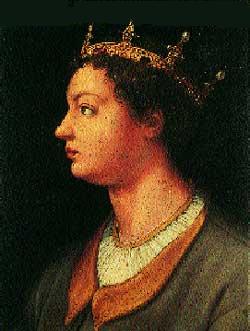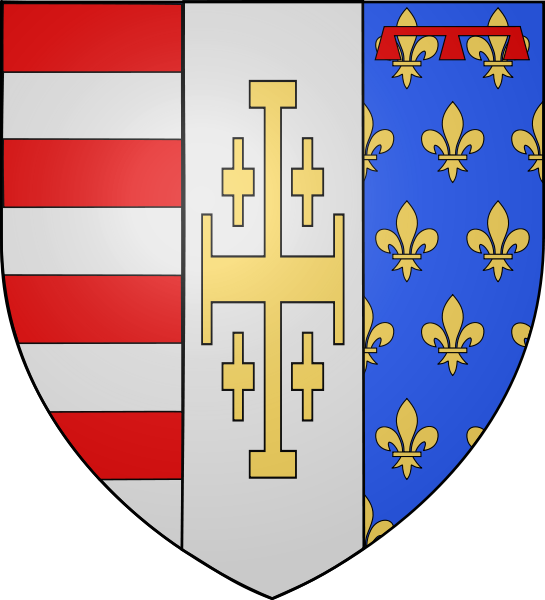<Back to Index>
- Humanist Gian Francesco Poggio Bracciolini, 1380
- Writer Else Lasker Schüler, 1869
- King of Naples Ladislaus, 1377
PAGE SPONSOR


Ladislaus the Magnanimous (Italian: Ladislao il Magnanimo di Napoli; 14 July 1376 or 11 February 1377 – 6 August 1414) was King of Naples and titular King of Jerusalem and Sicily, titular Count of Provence and Forcalquier (1386 – 1414), and titular King of Hungary and Dalmatia (1390 – 1414). He was the last male of the senior Angevin line.
He was named in honor to the King Saint Ladislaus I of Hungary, who was highly venerated by the Angevin King Charles I of Hungary, considered the model of the perfect King, Knight, and Christian man in Central Europe during that time. Ladislaus of Naples became a skilled political and military leader, protector and controller of the Papacy of Innocent VII. He profited from disorder throughout Italy to greatly expand his kingdom and his power, appropriating much of the Papal States to his own use. He was born in Naples, the son of Charles III and Margaret of Durazzo. He
became the King of Naples at the age of nine (1386) under his mother's
regency. Through the 1390s, he was constantly opposed by Antipope John XXIII, as well as by Louis II of Anjou, then head of the junior Angevin line, who contested the throne. Louis successfully seized Naples from him in 1390, and Ladislaus was forced to spend several years in the fortress of Gaeta. However, he had the favour of Pope Boniface IX,
as well as that of much of the Neapolitan population, who were
unwilling to support John XXIII. Several powerful barons of the Kingdom
decided to support him, and, in 1399, while Louis was fighting against
the count of Lecce, Ladislaus was able to re-enter Naples. The Angevins then decided to return to Provence. He was also the prince of Taranto from 1406, having taken Mary, Dowager Princess of Taranto and Countess of Lecce (1367 – 9
May 1446) as his third wife and barred her son from the principality.
Ladislaus first attempted to subjugate those fiefs by war and by
besieging the lady, but did not succeed in capturing her castle.
Therefore, he changed tactics: after negotiations, he succeeded in
persuading her to marry him. Ladislaus
endeavored to consolidate the royal power at the expense of the
baronial, and brought about the murder of several members of the Sanseverino family for frustrating his ends. In 1405, he went to Rome, where he helped the new Pope Innocent VII gain approval from the Roman population. In exchange, he was made rector of
the Roman countryside and seaside. However, a revolt forced Innocent to
flee and two powerful Roman baronial families, the Colonna and the Savelli,
called Ladislaus in; his attempt to obtain the seigniory of Rome was
however unsuccessful. He tried again in 1408, at the head of 12,000
cavalry and 12,000 infantry; after a short siege, he captured the city by bribing the Papal commander, Paolo Orsini; later, Perugia also fell into his hands. From 1390, he was also a claimant to the throne of Hungary and Dalmatia. His claim to the Crown of Hungary was opposed by Hungarian King Sigismund of Luxemburg, and Ladislas eventually sold his rights to the kingdom of Dalmatia to the Republic of Venice for 100,000 ducats in 1409. In the same year, Ladislaus invaded Tuscany, capturing Cortona and Elba Island from Gherardo Appiani. The Florentine condottiero Braccio da Montone defeated
his army, and Ladislaus was forced to retreat. However, he had not
abandoned his aims to northern Italy, also taking advantage of the
presence of Pope Gregory XII in Gaeta. Fearing his aims, the Republics of Siena and Florence and the powerful cardinal Baldassarre Cossa allied against him. Antipope Alexander V excommunicated him, calling Louis II of Anjou to
Italy to conquer Naples; the count of Provence arrived in Italy in late
July 1409 with 1,500 cavalry and was invested with the Neapolitan
crown. The league's troops, under Muzio Attendolo,
Braccio da Montone and other condottieri, invaded the Papal lands under
Ladislaus' control and moved to Rome; Orsini, left by Ladislaus to
protect the city, switched to them with 2,000 men. However, the allies
were only able to capture the quarter of Trastevere.
Cossa and Louis abandoned the siege to their condottieri, and moved to
northern Italy and Provence in search of further support. Ladislaus took advantage of an anti - French revolt in Genoa to
gain the support of that city (1410). Rome fell on 2 January, and the
allies did not score any other notable results. On 8 May, Louis' fleet,
carrying new troops from Provence, was intercepted and partly destroyed
off the Tuscan coast. In the meantime, Alexander had died, being
replaced by Cossa himself as John XXIII. John XXIII proclaimed a crusade against Ladislaus and authorised the sale of indulgences to finance it. (Jan Hus, the Czech reformer, protested against the sale of these indulgences in Bohemia, a protest which led to his death at Constance and the Hussite movement.) The
slow pace of the allied army led the Florentines and Sienese to accept
peace with Ladislaus, which he bought by renouncing some of his Tuscan
conquests. Louis continued the struggle, and crushed a Neapolitan army
at Roccasecca on
19 May. He proved unable to exploit this success, however, and soon
returned to Rome and Provence, where he died six years later. John
XXIII remained alone against Ladislaus, who bought the troops of Muzio Attendolo, while most of the Papal barons rebelled. A peace was signed on 14 June 1412, by which the Pope paid 100,000 florins, invested Ladislaus with the Neapolitan crown and named him as Gonfalonier; the King promised in turn to abandon the cause of Gregory XII. In
1413, Ladislaus marched northwards again, conquering and sacking Rome,
as well as most of the Papal States. As it was clearly the next
objective of the King, Florence forestalled him by signing a treaty of
peace. Having fallen ill, Ladislaus
was forced to return to Naples, where he died on 6 August 1414. Rumours
that he had been poisoned remain unproven. He is buried in the church of San Giovanni a Carbonara, where a monument was built over his tomb. He was succeeded by his sister Joan II of Naples, the last member of the senior Angevin line in Italy. Ladislaus married three times: First to Constance Chiaramonte in 1390. She was a daughter of Manfredi III Chiaramonte. They were divorced in 1392. Second to Mary of Lusignan (1381 – 1404) on 12 February 1403 in Naples. She was a daughter of James I of Cyprus. She died on 4 September 1404. Third to Mary of Enghien (1367 or 1370 – 9 May 1446), suo iure Countess of Lecce, daughter of John of Enghien,
in 1406. She survived him by thirty-two years. There were no children
from any of his marriages. However Ladislaus had at least two
illegitimate children.